CALCode Quarterly Fall 2023
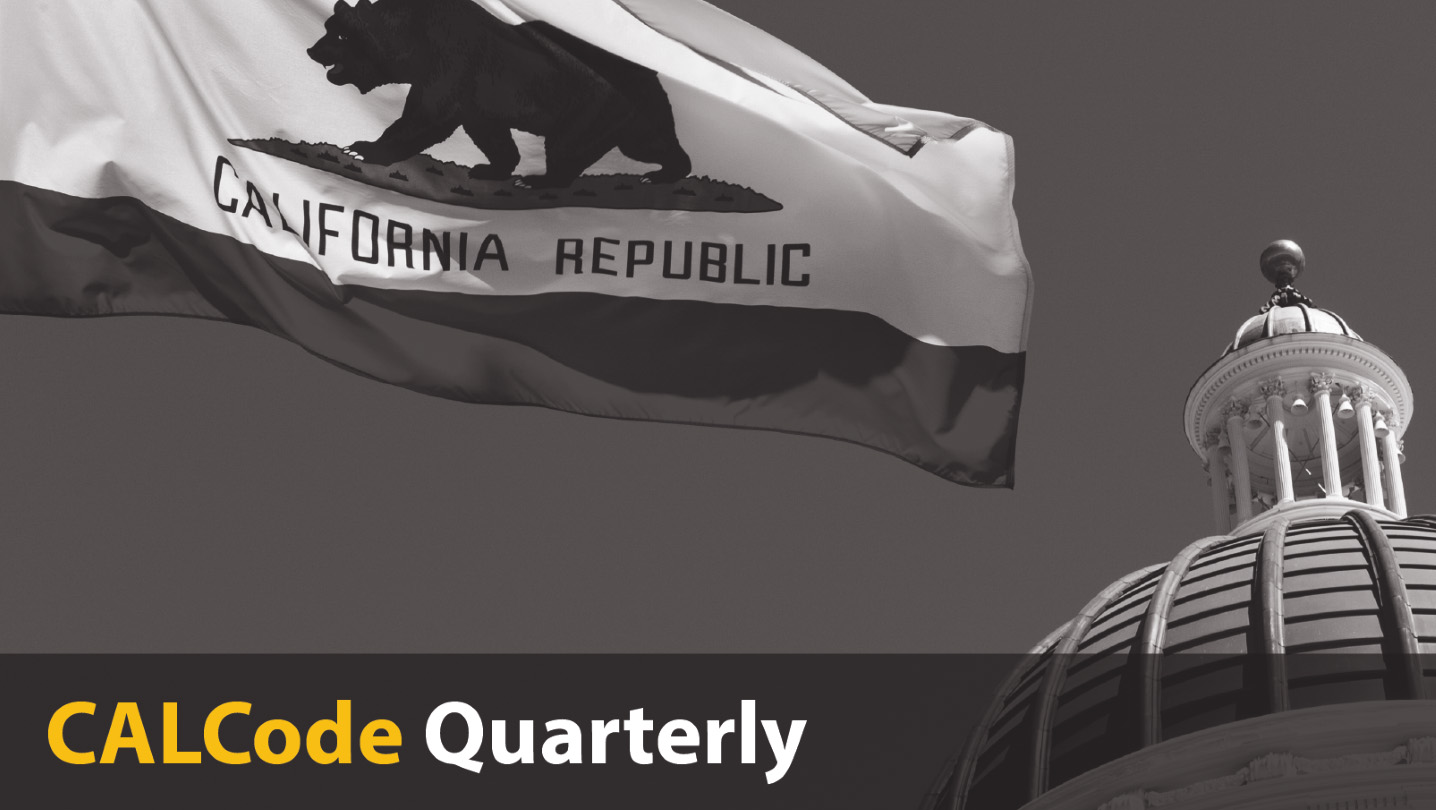

Acting Executive Director Message
Happy holidays! As festivities swirl around us, CBSC’s staff is hard at work on two code adoption cycles. First, we are wrapping up the 2022 Intervening Code Adoption Cycle for supplements to the 2022 edition of the California Building Standards Code, Title 24 of the California Code of Regulations (Title 24). This involves not only finalizing codification of the text of the regulations, but also creating educational publications to assist code users with identifying and complying with new standards. Codification is the preparation for printing of the blue supplement pages to be inserted into hard copies of the codes, as well as development of updated electronic versions, which are now preferred by many code users. These supplements will be published on January 1, 2024, and go into effect on July 1, 2024.
To help code users become familiar with the supplemental regulations in the 2022 edition of Title 24, CBSC prepares two helpful documents:
First, CBSC is compiling a summary of code updates for all affected parts of Title 24, with the exception the California Green Building Standards Code, Part 11 of Title 24 (known as CALGreen) that gets its own separate publication. The code updates summary will be available as a webpage and a downloadable PDF in early 2024. This publication was first developed for the 2022 triennial edition of Title 24 in response to public requests for this information, and we hope you find it useful. It will be posted to the Guidebooks on Title 24 webpage when complete.
Secondly, for CALGreen, CBSC is developing a supplement to the CALGreen Guide. This will be published and posted on our website for viewing and downloading in early 2024. Just like the printed guide available from the International Code Council, the supplement will provide the text of the new regulations, then the intent and suggested methods of compliance. CALGreen checklists, which are not regulatory, will also be updated to include new mandatory and voluntary measures. For more about CALGreen updates, be sure to check out the article about voluntary bird-friendly building standards in this edition of CALCode Quarterly, as well as an article about the new mandatory carbon reduction regulations originally published in the summer edition of the newsletter.
In other news, CBSC’s December commission meeting focused on appointing members to our six Code Advisory Committees (CACs) for the upcoming 2024 Triennial Code Adoption Cycle. Learn more about these committees in the cycle status article in this newsletter.
Additionally, CBSC is actively searching for candidates and interviewing to fill vacancies on our staff. We hope to have two limited-term CALGreen positions filled soon, and the commission will interview applicants for the vacant executive director (ED) position at a commission meeting in January. Note that CBSC’s ED is selected and appointed by the commissioners. We are very excited to see what the new year brings in terms of new staff and leadership at CBSC.
Currently, CBSC is also focusing on several mandates from bills passed in the recent legislative session. One of the most significant is Senate Bill 745 (Chapter 884, Statutes of 2023), known as the Drought-Resistant Buildings Act. This bill adds to and amends sections of the California Health and Safety Code and the Water Code, and requires CBSC to “research, develop, and propose building standards to reduce potable water use in new residential and nonresidential buildings, as specified. The bill would require the commission to perform a review of water efficiency and water reuse standards in the California Building Standards Code every three years, commencing with the next triennial edition, and update as needed.” CBSC will work with other state agencies such as the Department of Housing and Community Development, the State Water Resources Control Board, and the Department of Water Resources to meet the mandates of this bill.
An information bulletin about this and other new legislation impacting CBSC will be sent to our interested parties email subscribers and posted to our News page in January. If you know of anyone who may be interested and has not subscribed to CBSC’s mailing list, please share this with them. The link to sign up for emails can be found on our Contact Us webpage. We will also update our “History of the California Building Standards Commission” with the new legislation in early 2024.
In addition to the CALGreen and cycle status stories mentioned above, please be sure to check out the other articles in this newsletter, including information about how updates to the Bagley-Keene Open Meeting Act will affect future commission meetings, and a staff spotlight on Tom Martin. I hope you find these articles interesting and illuminating.
From all of us at CBSC, we wish you and yours a holiday season that is merry and bright.
Feature Articles
As final proofs for supplements to the 2022 edition of the California Building Standards Code, Title 24 of the California Code of Regulations (Title 24) are being put to bed, the California Building Standards Commission (CBSC) and other state agencies involved in the Title 24 rulemaking process are ramping up activities relative to the 2024 Triennial Code Adoption Cycle. A triennial cycle is required by law every three years to adopt new editions of model codes and make California amendments to implement new laws and mandates – or to carry out executive orders – related to building standards.
To kick off the cycle, CBSC and other agencies involved in the Title 24 code development process conduct focus groups and workshops to garner public input on draft regulations. Many of these have already occurred, with one remaining CALGreen Electric Vehicle Workgroup (CEVW) workshop scheduled for January 11, 2024. You may wish to subscribe to the mailing lists of other agencies such as the Department of Housing and Community Development, the Division of the State Architect, or the California Energy Commission to receive notice of and participate in their pre-cycle public meetings, if any.
Workshops and focus groups are when the public can have the most input into development of building standards, as this is where the code language is drafted and vetted with subject matter experts. Take a look at CBSC’s Public Guide to the Building Standards Adoption Process to learn more, including how to make a compelling public comment in support of your recommendations.
Next up will be the Code Advisory Committee (CAC) meetings that are required by Health and Safety Code (HSC) Section 18927. The six committees are made up of experts in different disciplines affected by Title 24 regulations, such as accessibility, green building, plumbing, electrical, mechanical and energy, among others. Each committee’s members are selected by the commissioners from a pool of candidates who submitted applications to CBSC. For the upcoming cycle, committee member selection took place on December 14, and you can view that commission meeting on CBSC’s YouTube channel.
Between March and July 2024, each of the six committees will meet to review and make recommendations to either approve, approve as amended, further study or disapprove the state agencies’ code proposals.
For every item reviewed by a CAC, anything other than “approve” must be supported by one of the nine-point criteria in HSC Section 18930. These criteria are designed to ensure that newly proposed regulations: 1) do not conflict with or duplicate other building standards; 2) are within the jurisdiction of the proposing state agency and not another’s; 3) are required to ensure public safety and environmental concerns are addressed; 4) are not unreasonable; 5) are cost-effective based on overall benefit; 6) are not ambiguous or vague; 7) appropriately incorporate national specifications and model codes, with statements required if a national standard or model code is inadequate or nonexistent; 8) are in the proper building standards format; and 9) are approved by the State Fire Marshal, if they promote fire and panic safety.
At a CAC meeting, the public is also invited to provide input and comments in support of or opposition to the newly proposed regulations. Commenters should be prepared with brief, succinct comments that provide the committee with actionable information relative to development of the building standards. Members of the public who wish to comment should also plan to adhere to the newly adopted regulation in the California Administrative Code, Chapter 1, Section 1-403 that limits an individual’s comments to four minutes, or eight minutes for some persons with disabilities. This time limit was codified during the 2022 Intervening Code Adoption Cycle and went into effect in July 2023. It is up to the chairperson of any particular meeting of a CAC or the commission to enforce this regulation.
To follow the 2024 Triennial Code Adoption Cycle, bookmark the cycle webpage and watch your emails for notices of public meetings and comment periods. All meeting dates will be posted on our Calendars tab and will also appear at the bottom of CBSC’s homepage.
For questions regarding cycle activities that are not answered here or on our website, please send an email to cbsc@dgs.ca.gov or call (916) 263-0916.
In 1953, California enacted the Ralph M. Brown Act (the Brown Act) to ensure the public’s right to attend and participate in meetings of local public agencies such as boards and commissions. Then, in 1967, the Bagley-Keene Open Meeting Act (Bagley-Keene) was added to the Government Code in Sections 11120-11133 to further facilitate accountability in and transparency of state government activities and protect the rights of citizens to participate in hearings, discussions, and deliberations.
With the advent of the COVID-19 pandemic in 2020, California had to act quickly to continue to conduct the state’s business while protecting public health and safety. This included making exceptions to Bagley-Keene. Following is a brief history of how these changes affected meetings of the California Building Standards Commission (CBSC).
2019 – February 2020 CBSC meetings are held in person with a quorum of commissioners together in one physical location. Meeting notices and agendas are posted on the internet and emailed to interested parties at least 15 days before the meeting, and the public is invited to attend either in person or via a telephone call-in line. These meetings are also livestreamed to YouTube and recorded for future viewing.
March 12, 2020
In response to the COVID-19 pandemic, California’s governor issues Executive Order (EO) N-25-20. Paragraph 11 of this EO suspends some provisions of the Brown Act and Bagley-Keene to allow agencies such as CBSC to hold public meetings electronically. Specifically, Paragraph 11 states:
“…a local legislative body or state body is authorized to hold public meetings via teleconferencing and to make public meetings accessible telephonically or otherwise electronically to all members of the public seeking to attend and to address the local legislative body or state body…”
July 2020 – October 2021
In accordance with additional executive orders N-29-20 and N-33-20, as well as recommendations from the California Department of Public Health, meetings of the commission do not have a physical location and are conducted using the Zoom virtual meeting platform. Meeting notices include a link for the public to join and participate via Zoom.
December 2021 – January 2022
CBSC meetings continue to be held virtually, consistent with Assembly Bill 361 (Chapter 165, Statutes of 2021).
April 2022
After expiration of the above EOs and bills, CBSC holds one hybrid commission meeting with some people present in person in Sacramento, and others attending virtually via Zoom.
January – June 2023
Senate Bill 189 (Chapter 48, Statutes of 2022), the 2022 budget trailer bill, Section 20, restores the Bagley-Keene waiver that allows boards and commissions to hold virtual meetings, and allows commissioners to participate remotely without having to disclose their location. This expires on July 1, 2023.
August 2023
Because of the sunset date on Senate Bill 189, CBSC holds its three-day August commission meeting at a physical location, and also offers the ability to participate via Zoom. Commissioners not present at the physical location, but who attend virtually, are not allowed to vote on any commission actions and instead participate as members of the public representing themselves.
September 2023
Senate Bill 143 (Chapter 196, Statutes of 2023) re-authorizes virtual meetings through December 31, 2023.
December 2023
In accordance with Senate Bill 143, CBSC’s public meetings continue to be held virtually. Meetings are accessible to the public via Zoom and have live captioning and American Sign Language interpretation services, as appropriate.
January 1, 2024
New legislation, Senate Bill 544 (Chapter 216, Statutes of 2023), will become effective on January 1, 2024. Until January 1, 2026, this legislation creates alternate Bagley-Keene requirements to conduct meetings and other proceedings virtually. In part, this legislation requires a majority of the commission to be physically present at the same location for all public meetings, with limited exceptions. The legislation permits additional commissioners exceeding a majority to participate from remote locations without including the remote meeting locations in the meeting notice or making them accessible to the public. As a result of the new legislation, effective January 1, 2024, CBSC will have a physical location where the majority of the commissioners will be present and the public can participate, and will also offer the ability to participate via Zoom.
Although a majority of commissioners and limited CBSC staff will attend and participate in each meeting at a physical location as of January 1, 2024, stakeholders are encouraged to continue to access and participate in CBSC’s public meetings via Zoom. However, should stakeholders wish to participate in public meetings in person instead of via Zoom, the location for each public meeting will be included on the meeting notice.
For more information regarding Bagley-Keene, the Office of the Attorney General has produced an updated Bagley-Keene Open Meeting Act Guide (2023) and a one-hour training video that describe the various current Bagley-Keene requirements. Note that these two resources do not include information regarding the Government Code change enacted by Senate Bill 544.
The current text of the Bagley-Keene Open Meeting Act is located on the California Legislative Information website.
CALCode Quarterly would like to recognize and thank Staff Services Analyst Pamela Maeda for her contributions to this article.
The California Green Building Standards Code, Part 11 of Title 24 of the California Code of Regulations (CALGreen), is an ever-evolving set of regulations that promote sustainable building practices. Over the years, the codes have evolved from all-voluntary to both mandatory and voluntary measures in five categories: Planning and Design, Energy Efficiency, Water Efficiency and Conservation, Material Conservation and Resource Efficiency, and Environmental Quality.
During the 2022 Intervening Code Adoption Cycle, CBSC proposed voluntary bird-friendly building design measures in the Planning and Design division of CALGreen for nonresidential buildings. The goal is to reduce the negative environmental impact of bird deaths caused by collisions with buildings. These bird-friendly regulations were the result of years of effort by former CBSC Senior Architect Jane Taylor (who served from 2004-2012), who worked with current CBSC Associate Construction Analyst Beth Maynard (2019-present) to draft the proposal that was approved by the commission last August. CALGreen’s bird-friendly building design standards are voluntary and would only become mandatory if adopted in a local jurisdiction’s ordinance. These standards are intended to help architects, builders and developers create buildings and structures that are safe for birds throughout California.
Bird-friendly measures were initially proposed in 2008 for the very first edition of CALGreen, as well as in several subsequent code adoption cycles. Ms. Taylor drafted the regulations after researching existing guidelines such as the Green Globes (similar to LEED) and gathering input from practicing architects and bird-collision experts. In the GREEN Code Advisory Committee (CAC) meetings, these proposals met with requests for further study, as well as resistance from some stakeholders in the building industries. They ultimately did not move forward for approval by the commission.
After her retirement, Ms. Taylor submitted a petition to CBSC in 2019 requesting the development of voluntary bird-friendly standards. This petition was accepted by CBSC and work began on drafting measures that would pass CAC review and be approved by the commission. For more information about petitions, see California Administrative Code Section 1-313 to 1-329.
CALCode Quarterly interviewed Jane and Beth to find out more about their interest in – and efforts to develop – bird-friendly building standards for CALGreen.
Jane, what prompted you to become interested in bird-friendly construction?
The mid-rise, glass-clad building adjacent to CBSC’s office was often surrounded in the morning by dead birds killed by collisions as they migrated and foraged locally. I was shocked by the number of casualties. With Green Globes as an example, I reached out to experts in the U.S. who could help draft building standards to prevent carnage to birds already affected by habitat loss [and] climate change.
Who did you work with after you submitted your petition to CBSC in 2019?
A couple of years after my retirement, I submitted a petition to include voluntary bird-friendly standards in CALGreen. With (former CBSC Executive Director) Mia Marvelli’s leadership, and Beth Maynard’s diligence, the Energy Commission and Fire Marshal were brought on board. The building [industry representatives] at the CAC meeting relented and, with a few minor changes, approved bird-friendly regulations for commission consideration in 2023.
Please describe your feelings when the commission approved the regulations in August 2023.
Enormous relief, but frustration that [the commission] hadn’t been able to evaluate the standards before 2023.
What’s next? Will you continue your efforts and advocate for mandatory measures?
I would like to let jurisdictions and agencies adopt the standards and see how much interest there is. Research into the adoption rate might be a future step on a road to proposing mandatory [bird-friendly regulations].
At last cycle’s CAC and commission meetings, Beth Maynard represented the Building Standards Commission (BSC) as the agency proposing the voluntary standards.
Beth, please tell us your background relative to bird-friendly building design?
I first learned about this topic when bird-friendly design standards were proposed during the 2019 Intervening Code Adoption Cycle in response to Jane’s petition, and I then became involved in BSC’s effort for the 2022 intervening cycle. I did a lot of research and asked a lot of questions to help draft the proposal that was finally approved.
What did you learn while working on the regs?
I’ve learned about the impact buildings have on birds flying by day or night—I had no idea that so many birds die by colliding with buildings. It has truly opened my eyes. I am grateful to be given the opportunity to work on these regulations to expand my knowledge, because there is still so much more to learn. And, I have found a new fondness for all birds, not just the ones in my backyard!
What did you enjoy most about working with Jane and the other avian advocates?
I loved working with Jane and the many other advocates, and admire the passion they have for their work in helping birds. They all have been extremely helpful throughout the process. With the little knowledge I had, they were always willing to help answer many of the questions I had.
What do you see in the future for bird-friendly building standards?
What I really hope to see is a new awareness from people just like me who had no knowledge of how buildings impact the birds’ environment. And with the new awareness, more contractors, owners, architects and designers who plan to design buildings with bird-friendly standards.
CBSC will be publishing a supplement to the CALGreen Guide after the new codes are published in January. This publication provides code text, intent, and application and enforcement suggestions. To view the guide and learn more about the development of green building standards in California, visit the CALGreen webpage. To follow current and future code adoption cycles, visit our Rulemaking page.
Tom Martin’s unique background and experience are very beneficial to his colleagues and responsibilities at the California Building Standards Commission (CBSC). When Tom joined CBSC last year, we introduced him on our About Us page. Now, CALCode Quarterly has asked him to share a bit more of his history with us.
Tom, what was your background before you began working in building standards development?
I started out as a jeweler making and repairing jewelry for a couple of local jewelry shops. After that, I was an electrician for 20-plus years, working on all types of projects, both residential and commercial. I didn’t go to school for either of those jobs, but later I earned an associate of arts in Building Inspection Technology because I wanted to become a building inspector.
What prompted you to join state service?
I was looking for a job as a building inspector. I had just graduated with my AA and saw a job posting for a District Representative, Division of Codes and Standards, for the Department of Housing and Community Development (HCD). I had no idea what that job was, but I applied, was interviewed, and offered the job. I accepted it not knowing what I would be doing and gradually learned that the job involved writing building codes for residential occupancies in the state. Eventually, I realized that I really like code development and am pretty good at it.
As you have learned more about the development of state regulations, what do you feel you contribute?
My goal is to help write the codes so the average construction worker will be able to understand and apply them.
CALCode Quarterly notes that with his electrician’s background, Tom has been able to assist HCD and now CBSC with the development of standards for electric vehicle charging for both residential and non-residential applications. Having someone on staff who has used the codes helps with creating building standards that are reasonable and clear, which aligns with CBSC’s mission of developing sensible and usable regulations.
What’s one of the most interesting or surprising things you’ve learned or seen during your career?
When you modify the code to try and make it clearer, you may clarify it for some people, but then it might be less clear for the people who understood it before you changed it. I have come to realize that there may be no way to write it so everyone understands and interprets it the same way, but we’ll keep on trying!
Any advice for our readers interested in the building trades or code enforcement and development?
I think a building trade can be a great career opportunity for someone young, but you do tend to abuse your body and need to get into a foreman position before you get too old…or move into code enforcement or development! That worked for me!
For more information on state of California careers and job classifications, visit the CalCareers website.
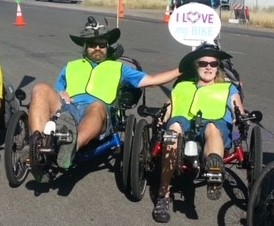
Tom Martin and his wife, Candis, on their recumbent bikes
Education and Outreach
Matrix Adoption Tables and Agency Adoptions in Title 24
In an effort to make the California Building Standards Code, Title 24 of the California Code of Regulations (Title 24) easier to use, CBSC developed Matrix Adoption Tables (MATs). These tables—placed at the beginning of code chapters—are designed to help code users determine which code sections apply to their projects. While every effort has been made to make MATs simple to understand, they can still be confusing. This is why CBSC developed a video that explains the authorities of the different state agencies that contribute to Title 24, and how to look at and benefit from the information in MATs. Sometimes, even after watching the video, code users still have questions and CBSC is happy to provide clarification.
Recently, two California organizations invited Associate Architect Irina Brauzman to speak to their groups and answer questions regarding Title 24 and MATs. CSG Consultants, an engineering firm, and NorCal NECA, the National Electrical Contractors Association, both spent about an hour with Irina discussing how different agencies contribute to Title 24 for specific occupancies and applications, and how to use the MATs. If you and your team members are interested in this topic, watch the Matrix Adoption Tables in Title 24 video on CBSC’s YouTube channel. If you still have questions and want to arrange a Q&A session, contact us at cbsctraining@dgs.ca.gov.
Department of General Services Turns 60!
CBSC staff attended the Department of General Services’ (DGS’) 60th anniversary celebration at the Ziggurat building on October 26. In attendance were Government Operations Agency Secretary Amy Tong and DGS Director Ana Lasso, who both spoke about past achievements and upcoming goals of DGS. CBSC Staff Services Analyst Pamela Maeda and Architectural Associate Timothy O’Malley hosted CBSC’s table at the event, where they met with DGS leadership and colleagues, and informed them about CBSC’s activities and mission.
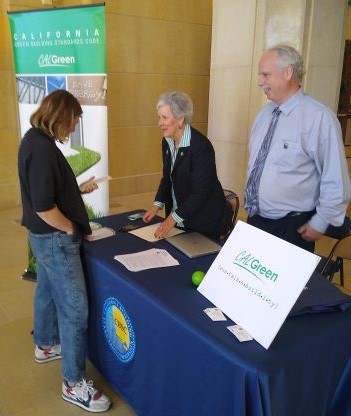
Pamela Maeda and Timothy O'Malley with a visitor
County Building Officials Association of California
Associate Architect Irina Brauzman attended the annual meeting of County Building Officials Association of California (CBOAC) in Monterey on November 1. Also in attendance were representatives of the Division of the State Architect (DSA), the California Energy Commission (CEC) and the State Fire Marshal (SFM). The building officials in attendance were provided with information about new and updated building standards resulting from the recently concluded 2022 Intervening Code Adoption Cycle (see the Cycle Status article in this issue for more information). CBSC always enjoys attending these events, as it gives us a chance to meet and speak with the building officials who are responsible for learning about and enforcing the regulations in Title 24.
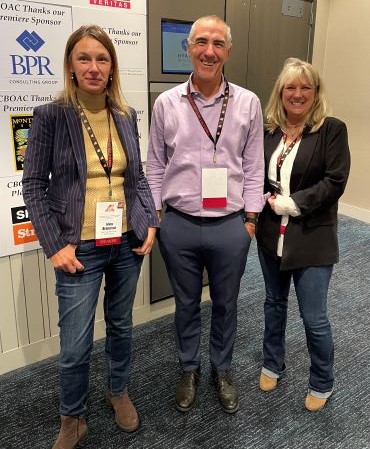
Irina Brauzman, Eric Driever of DSA, Beth Maynard
Rulemaking Training for State Agency Representatives
In October, CBSC conducted an all-day rulemaking training session for state agency representatives who are involved in the rulemaking process for Title 24. This session happens before each rulemaking cycle and provides in-depth instruction to staff who are new to the process, as well as high-level information for experienced code developers. Just about every CBSC staff member was involved in developing and presenting the material, and we were pleased to receive positive reviews from our trainees. For more information about CBSC’s rulemaking process, visit our Resources tab and go to Guidebooks on Rulemaking where we have posted information for the public as well as state agency staff.
Staff Recognition
Recently, Acting Executive Director Kevin Day and Education and Outreach Coordinator Laura Mills each received certificates recognizing their contributions to CBSC and the public. Kevin was nominated by a colleague for an internal DGS Values Award. The Values Award recognizes DGS employees who exhibit the values of integrity, accountability, communication, excellence, innovation, and teamwork, all of which Kevin does daily! Laura was recognized by CBOAC for her contributions to the annual meeting by arranging for CBSC’s attendance and presentations.
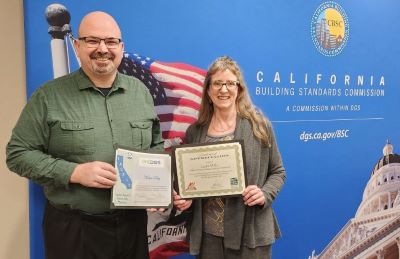
Kevin Day and Laura Mills
Coming next year…
California Building Officials Annual Business Meeting in April 2024
If you’re attending, be sure to look for CBSC and other state agency representatives at the California Building Officials (CALBO) meeting in April. We are planning an informative presentation regarding new CALGreen regulations that will go into effect July 1, 2024.
Educational Publications
If you want to learn about the Title 24 changes and additions to be published January 1, 2024, and going into effect July 1, 2024, please watch for two new publications coming soon:
Summary of Code Changes – Supplements to the 2022 Edition of Title 24. This will be published on CBSC’s Resources tab as a webpage and a downloadable PDF shortly after the first of the new year.
CALGreen Guide Update – Nonresidential Supplements. A companion to the 2022 Guide to the California Green Building Standards Code - Nonresidential, this document will be posted to the CALGreen webpage for users to download.
Contact CBSC for More Information or Training
CBSC has subject matter experts who can share information regarding how to use Title 24, the rulemaking process for building standards, and the history and development of the California Green Building Standards Code, Part 11 of Title 24 (CALGreen), including recent nonresidential code updates. Reach out to us at cbsctraining@dgs.ca.gov for more information.
